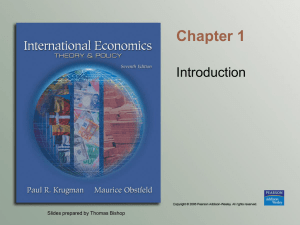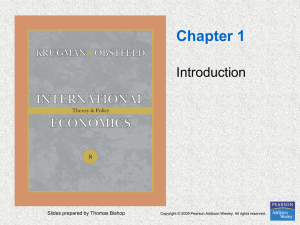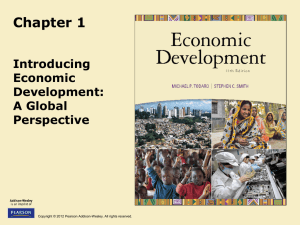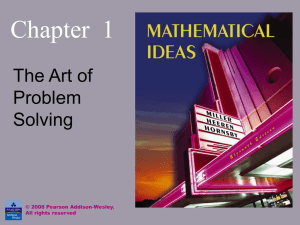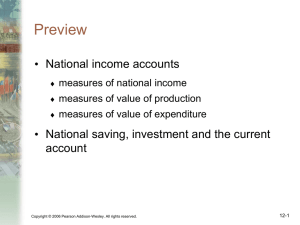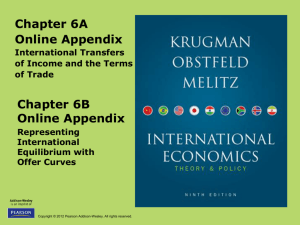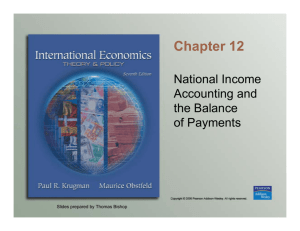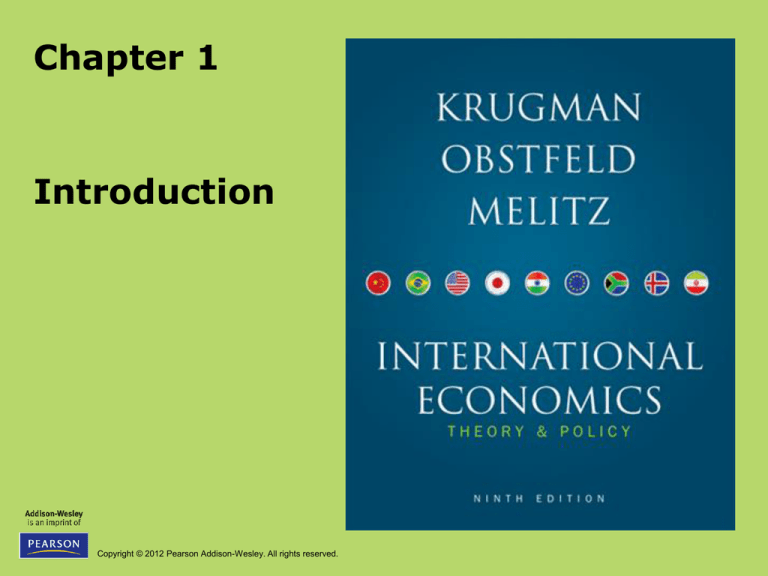
Chapter 1
Introduction
Copyright © 2012 Pearson Addison-Wesley. All rights reserved.
Preview
• What is international economics about?
• International trade topics
– Gains from trade, explaining patterns of trade,
effects of government policies on trade
• International finance topics
– Balance of payments, exchange rate
determination, international policy coordination
and capital markets
• International trade versus finance
Copyright © 2012 Pearson Addison-Wesley. All rights reserved.
1-2
What Is International Economics About?
• International economics is about how
nations interact through:
– trade of goods and services, flows of money,
and investment.
• International economics is an old subject,
but continues to grow in importance as
countries become tied more to the
international economy.
• Nations are now more closely linked than
ever before.
Copyright © 2012 Pearson Addison-Wesley. All rights reserved.
1-3
What Is International Economics About?
(cont.)
• International trade as a fraction of the
national economy has tripled for the U.S. in
the past 40 years.
– Both imports and exports fell in 2009.
• Compared to the U.S., other countries are
even more tied to international trade.
Copyright © 2012 Pearson Addison-Wesley. All rights reserved.
1-4
Fig. 1-1: Exports and Imports as a
Percentage of U.S. National Income
Source: U.S. Bureau of Economic Analysis
Copyright © 2012 Pearson Addison-Wesley. All rights reserved.
1-5
Fig. 1-2: Exports and Imports as
Percentage of National Income in 2007
Source: Organization for Economic Cooperation and Development
Copyright © 2012 Pearson Addison-Wesley. All rights reserved.
1-6
Gains from Trade
• Several ideas underlie the gains from
trade.
1. When a buyer and a seller engage in a
voluntary transaction, both can be made better
off.
• Norwegian consumers import oranges that they
would have a hard time producing.
• The producer of the oranges receives income that it
can use to buy other things that it desires.
Copyright © 2012 Pearson Addison-Wesley. All rights reserved.
1-7
Gains from Trade (cont.)
2. How could a country that is the most (least)
efficient producer of everything gain from trade?
•
Countries use finite resources to produce what they are
most productive at (compared to their other production
choices), then trade those products for goods and
services that they want to consume.
•
Countries can specialize in production, while consuming
many goods and services through trade.
Copyright © 2012 Pearson Addison-Wesley. All rights reserved.
1-8
Gains from Trade (cont.)
3. Trade benefits countries by allowing them to
export goods made with relatively abundant
resources and imports goods made with
relatively scarce resources.
4. When countries specialize, they may be more
efficient due to larger-scale production.
5. Countries may also gain by trading current
resources for future resources (international
borrowing and lending) and due to international
migration.
Copyright © 2012 Pearson Addison-Wesley. All rights reserved.
1-9
Gains from Trade (cont.)
• Trade is predicted to benefit countries as a
whole in several ways, but trade may harm
particular groups within a country.
– International trade can harm the owners of
resources that are used relatively intensively in
industries that compete with imports.
– Trade may therefore affect the distribution of
income within a country.
Copyright © 2012 Pearson Addison-Wesley. All rights reserved.
1-10
Patterns of Trade
• Differences in climate and resources can explain
why Brazil exports coffee and Australia exports
iron ore.
• But why does Japan export automobiles, while the
U.S. exports aircraft?
• Why some countries export certain products can
stem from differences in:
– Labor productivity
– Relative supplies of capital, labor and land and their use in the
production of different goods and services
Copyright © 2012 Pearson Addison-Wesley. All rights reserved.
1-11
Effects of Government Policies on Trade
• Policy makers affect the amount of trade through
– tariffs: a tax on imports or exports,
– quotas: a quantity restriction on imports or exports,
– export subsidies: a payment to producers that export,
– or through other regulations (ex., product specifications)
that exclude foreign products from the market, but still allow
domestic products.
• What are the costs and benefits of these policies?
Copyright © 2012 Pearson Addison-Wesley. All rights reserved.
1-12
The Effects of Government Policies
on Trade (cont.)
• If a government must restrict trade, which policy
should it use and how much should it restrict
trade?
• If a government restricts trade, what are the costs
if foreign governments respond likewise?
• Trade policies are often chosen to cater to special
interest groups, rather than to maximize national
welfare.
• Governments tend to adopt tariffs, then negotiate
them down in exchange for reduction in trade
barriers of other countries.
Copyright © 2012 Pearson Addison-Wesley. All rights reserved.
1-13
International Finance Topics
• Exchanging risky assets such as stocks and
bonds can benefit all countries by
diversification that reduces the variability
of income – another source of gains from
trade.
• Most international trade involves monetary
transactions.
• Many monetary events have important
consequences for international trade.
Copyright © 2012 Pearson Addison-Wesley. All rights reserved.
1-14
Balance of Payments
• Governments measure the value of exports and
imports, as well as the value of financial assets
that flow into and out of their countries.
– Trade deficits, where countries import more than they
export in value, may be offset by net inflows of financial
assets.
• The official settlements balance, or the balance of
payments, measures the balance of funds that
central banks use for official international
payments.
• All three values are measured in the government’s
national income accounts.
Copyright © 2012 Pearson Addison-Wesley. All rights reserved.
1-15
Exchange Rate Determination
• Exchange rates are an important financial issue for
most governments.
• Exchange rates measure how much domestic
currency can be exchanged for foreign currency
and thus affect:
– how much goods denominated in foreign currency
(imports) cost in the domestic country.
– how much goods denominated in domestic currency
(exports) cost in foreign markets.
• Some exchange rates change continually (float)
while others are fixed for periods of time.
Copyright © 2012 Pearson Addison-Wesley. All rights reserved.
1-16
International Policy Coordination
• In an integrated economy, one country’s economic
policies usually affect other countries as well,
leading to the need for some degree of policy
coordination.
– Depends on type of exchange rate regime.
• Capital markets, where money is exchanged for
promises to pay in the future, have special
concerns in an international setting:
– Currency fluctuations can alter the value paid.
– Countries, especially developing ones, might default on
debt.
Copyright © 2012 Pearson Addison-Wesley. All rights reserved.
1-17
International Trade Versus Finance
• International trade focuses on transactions
involving movement of goods and services
across nations.
– International trade theory (chapters 2–8) and
policy (chapters 9–12)
• International finance focuses on financial or
monetary transactions across nations.
– International monetary theory (chapters 13–18)
and policy (chapters 19–22)
Copyright © 2012 Pearson Addison-Wesley. All rights reserved.
1-18



